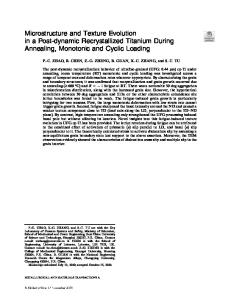Evolution of Texture and Microstructure in Commercially Pure Titanium with Change in Strain Path During Rolling
- PDF / 1,776,530 Bytes
- 11 Pages / 593.972 x 792 pts Page_size
- 0 Downloads / 390 Views
ODUCTION
TITANIUM and its alloys find extensive use in aerospace, biomedical, and chemical industries due to high specific strength, excellent biocompatibility, and corrosion resistance.[1] Due to the inherent anisotropy of the unit cell, pure titanium and single-phase a titanium alloys are characterized by strong asymmetry in various properties.[2] Of particular importance is the evolution of crystallographic texture during various thermomechanical processes. Rolling is one of the most commonly used forming techniques for titanium, and the deformation texture evolution during rolling has been extensively studied.[2–6] The evolution of pronounced textures in hexagonal close-packed (HCP) materials in general, and titanium in particular, leads to significant anisotropy in the mechanical properties. One of the commonly used procedures to achieve low anisotropy in rolled sheets is subjecting the material to cross rolling instead of unidirectional rolling. This procedure involves change in strain path by a rotation of 90 deg between the intermittent passes. It has been successfully used in various cubic materials to produce sheets with weaker texture, lower strength, and isotropic properties.[7–9] In addition, crystallographic texture, the dislocation substructure[10,11] that evolves during plastic deformation, is also altered due to strain path change. Schmitt et al.[12] have provided a scalar parameter h that varies between 0 and 1 to describe N.P. GURAO, Postdoctoral Fellow, is with the Department of Mechanical Engineering, University of Saskatchewan, Saskatoon S7N 5A9, Canada. S. SETHURAMAN, Engineer, is with Cummins Inc., Buffalo, NY 14225. SATYAM SUWAS, Associate Professor, is with the Department of Materials Engineering, Indian Institute of Science, Bangalore 560012, India. Contact e-mail: satyamsuwas@materials. iisc.ernet.in Manuscript submitted April 15, 2012. Article published online October 25, 2012 METALLURGICAL AND MATERIALS TRANSACTIONS A
the extent of strain path change. It has been found that a change in strain path, caused by changing the direction of rolling, strongly affects the texture formation and substructure evolution after deformation as well as postdeformation annealing in a variety of single- and two-phase materials like copper and copper alloys, single- and twophase brass, nickel, and titanium alloys.[13–24] The idea behind the different modes of rolling is derived from the instability of substructure caused by deformation along a new rolling direction that in turn affects the evolution of deformation texture. The change in strain path leads to destabilization of the substructure as well as deformation texture components formed during previous rolling. However, this simplified proposition may not be extended for anisotropic HCP metals like titanium. In addition, there is hardening in HCP titanium during biaxial tension that is attributed to texture hardening.[25] It was further suggested that the evolution of basal texture during biaxial tension was responsible for the texture strengthening. Although
Data Loading...











